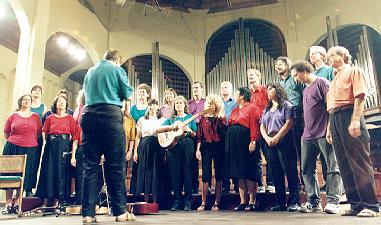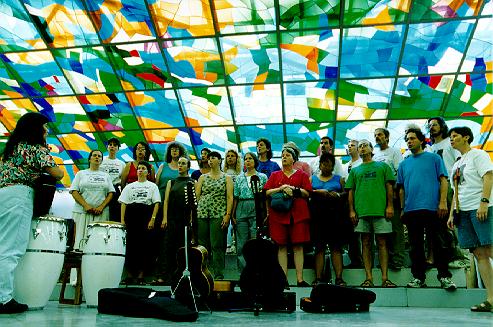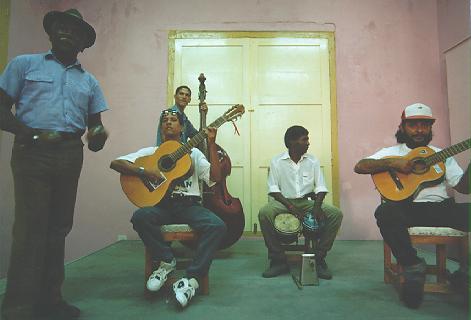 We flew to Cuba from Cancun, Mexico, in an old Russian turbo-prop.
Here is a
picture of the inside of the cockpit,
taken with a 21mm wide-angle lens.
We flew to Cuba from Cancun, Mexico, in an old Russian turbo-prop.
Here is a
picture of the inside of the cockpit,
taken with a 21mm wide-angle lens.
In some ways, Americans know more about Cuba than they do about other Latin American countries. Everyone knows who Fidel Castro is (do you know the name of the leader of any other Latin American country?) Most of us have heard of Che Guevara, know about the Bay of Pigs invasion and the Cuban Missle Crisis, or even know about Teddy Roosevelt and the charge of the Rough Riders up San Juan Hill.
I went to Cuba in December 1995 with the La Peña Community Chorus. The purpose of the trip was to attend a music festival in Santiago de Cuba. I had long been curious about Cuba, and had many questions; however, after 10 days there, I had even more questions and very few answers.
There is one thing, however, I am sure of. We must...
 We flew to Cuba from Cancun, Mexico, in an old Russian turbo-prop.
Here is a
picture of the inside of the cockpit,
taken with a 21mm wide-angle lens.
We flew to Cuba from Cancun, Mexico, in an old Russian turbo-prop.
Here is a
picture of the inside of the cockpit,
taken with a 21mm wide-angle lens.
In fact, lots of things are old in Cuba.
Because of the US trade embargo, and because they have lost their aid
from the former Soviet Union, almost everything is in short supply.
Cuba has an excellent medical system, but they lack medicines, even bandages.
Basic toiletries, like soap, are almost nonexistant, as are
school and office supplies, such as pens and paper.

Gasoline is especially a problem. There are few busses anymore.
Instead, horse-drawn carts and flat-bed trucks provide transportation.
Cubans are masters at keeping old automobiles running,
and you see many classics on the streets.
Here are photos of two other old cars.
Because the government needs hard currency, they are embracing tourism.
Trying to attract upscale tourists, while keeping a socialist
economy, leads to many contradictions.
Despite the lack of gasoline, it is not difficult for a tourist to
get a taxi, as long as you stick to the normal tourist areas.
Perhaps worst are the tourist hotels, beaches, and clubs that are
simply off-limits to Cubans -- sort of a bizarre tourist apartheid.
Prostitution is flourishing in tourist areas, and with typical
socialist efficiency. At our hotel there were three women on
staff whose main job seemed to be getting friendly with the guests.
Tourism has also led to begging.
 When the Russians pulled out, they were in the middle of building
a freeway system. Now, of course, there are hardly any cars on
the roads.
When the Russians pulled out, they were in the middle of building
a freeway system. Now, of course, there are hardly any cars on
the roads.
This stream is used as a car wash. The Cubans tend
to be a fairly neat and tidy people. Besides, if you keep something
clean it will usually last longer.
 We stayed in a hotel called the Villa San Juan. It is right
on the famous San Juan hill, so the chorus couldn't resist making
its own charge up the hill.
We stayed in a hotel called the Villa San Juan. It is right
on the famous San Juan hill, so the chorus couldn't resist making
its own charge up the hill.
Ok, I've now covered all the normal tourist stuff (how to get
there, how to get around, where to stay). Oh yeah, the weather.
Even though it was December, it was hot and humid. A little rain.
The forecast calls for brief power outages over most of the city.

 The chorus was going for the International Choral Festival,
which featured choirs from all over the world.
We were the first chorus from the US to attend, and because
of this, we were treated like celebrities.
The chorus was going for the International Choral Festival,
which featured choirs from all over the world.
We were the first chorus from the US to attend, and because
of this, we were treated like celebrities.
Things often became emotional.
Early in the trip we met with the National Chorus of Cuba.
They are professionals (and sing like angels),
and we are some goofball amateurs from a
community center in Berzerkeley, but when we got together
in friendship everyone started to cry.
I know it sounds stupid; maybe you had to be there.
(Alison talks about this in her essay.)
 We gave several performances during the week.
The rest of the time, we were meeting other choirs and groups,
and listening to music.
We even squeezed in two trips to the beach.
We gave several performances during the week.
The rest of the time, we were meeting other choirs and groups,
and listening to music.
We even squeezed in two trips to the beach.
But we mainly went to meet people. A few people in the chorus
had been to Cuba before. For most of us, it was our first time.
I do quite a bit of traveling, but I have to say that this
is one of the most intense trips I have ever been on.
 I had been told before I went that Cubans are very friendly.
Here is a group from another chorus that we invited over to
our hotel. We stayed up most of the night, singing and talking.
I had been told before I went that Cubans are very friendly.
Here is a group from another chorus that we invited over to
our hotel. We stayed up most of the night, singing and talking.
If you were walking down the street, people would normally start
to talk to you.
Despite their concern that it was dangerous to say bad things
about the government to tourists, most people seemed willing
to tell you what they thought about their country, their
government, the US, or anything else.
 People would invite you into their homes.
One day when I was walking down the street by myself, I heard
music coming from an open door. I stuck my head in (as in
most Latin countries, the front door is right on the sidewalk),
and was promptly invited in.
There was a group of four musicians: a singer (pictured
at right), a guitarist, another guitarist playing a "tres" guitar,
and a percussionist.
We sang "Besame Mucho", and "Son de la Loma" (one of the more
popular songs in Cuba).
People would invite you into their homes.
One day when I was walking down the street by myself, I heard
music coming from an open door. I stuck my head in (as in
most Latin countries, the front door is right on the sidewalk),
and was promptly invited in.
There was a group of four musicians: a singer (pictured
at right), a guitarist, another guitarist playing a "tres" guitar,
and a percussionist.
We sang "Besame Mucho", and "Son de la Loma" (one of the more
popular songs in Cuba).
The friendliness of the Cuban people was one of the things
that confused me.
Often, it was difficult to distinguish between
people who were genuinely friendly, and people who were
being friendly because they wanted something from you.
Even beggars were very friendly. They would talk to you,
ask you curious questions, and then gradually tell you how rough
things were (which they are, indeed) and ask you for some money.
It was difficult to resist.
After all, one dollar is three day's average salary.
 After a while, so much friendliness became overwhelming.
I remember going snorkling on the last day of the trip,
and swimming way out away from everyone, and just drifting
along with the fish, thinking how wonderful it was to be alone.
After a while, so much friendliness became overwhelming.
I remember going snorkling on the last day of the trip,
and swimming way out away from everyone, and just drifting
along with the fish, thinking how wonderful it was to be alone.
Most of the time, however, being treated like celebrities was charming. We visited a school, and were welcomed with a parade.
Another group of students from the medical school invited
us to a dance performance, featuring Cuban, African, and Creole
(Haitian) dances.
It was one of the most incredible and erotic dance performances
I have ever seen.
Here are six photographs of the dancing.

The picture on the right is a group in the "Casa de Trova" (house of troubadors). Here is a good closeup of the singer. There are more photographs of Cuban music on this page of Cuban People.
And almost anywhere that there was music, there was also dancing.
Below is a picture of the chorus,
getting into the spirit of things at the Casa de Trova.
 The woman at the far left (in the white shirt and pants) is
Teresita, our interpreter, guide, and honorary mother.
Because she was acting like a jewish mother,
we started to teach her Yiddish. By the end of the
week she would get us to go by yelling "vamanos mashuganos".
The woman at the far left (in the white shirt and pants) is
Teresita, our interpreter, guide, and honorary mother.
Because she was acting like a jewish mother,
we started to teach her Yiddish. By the end of the
week she would get us to go by yelling "vamanos mashuganos".

Here is a page of photographs of street scenes in Santiago de Cuba.
Here is a page of photographs of the countryside of Cuba. Includes photos of dinosaurs!
Here is a page of photographs of dancing.
Here are two photographs of old cars.
The child in the picture to the right is playing with a
balloon made from an inflated condom.
Here are excerpts from a Christmas letter from two other members of the chorus, describing the highlights of our trip.
Global Exchange. Information about Cuba, and travel to Cuba. Highly recommended.
The Washington Post web page on Cuba.
Lonely Planet's wonderful (as usual) guide to Cuba.
Cuba Travel Pictures by David Stanley, the original author of Lonely Planet Cuba.
A Cuban who offers tours of Cuba, including to US citizens.